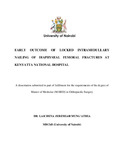| dc.contributor.author | Mung’athia, Laichena J | |
| dc.date.accessioned | 2017-12-08T13:22:47Z | |
| dc.date.available | 2017-12-08T13:22:47Z | |
| dc.date.issued | 2017 | |
| dc.identifier.uri | http://hdl.handle.net/11295/101720 | |
| dc.description.abstract | Diaphyseal femoral fractures are common injuries seen at Kenyatta National Hospital with an average of 508 fractures being admitted annually. Locked Intramedullary nailing is now the gold standard for the treatment of diaphyseal femoral fractures and functional outcomes are good. Locked nailing is done either closed with an image intensifier or open with a proximal and distal locking jig. The locked nails used are from different manufactures and have different manufacture’s preferred specifications on the fixation.
At KNH both methods are used, and the surgeries are carried out by Orthopaedic surgeons and residents at different levels of training.
Major complications of intramedullary nailing are low internationally, at around 5%. Some of them are angular and rotational malalignment, limb length discrepancy, decreased knee and hip range of motion. At KNH, the only study on ILN is on complications of diaphyseal fractures has been on the infection rates.
This study examined a group of patients treated at Kenyatta National Hospital which is a trauma Centre serving a big population of over 4.5 million in Nairobi and its environs. The outcomes examined were angular and rotational malalignment, limb length discrepancy, range of motion of the hip and knee joints and presence of callus at 12 weeks after the surgery. The above parameters have not been studied before in our setting.
Objective: To determine the early outcomes of diaphyseal femoral fractures treated by locked intramedullary nail at KNH
Design: A prospective observational study.
Setting: Orthopaedic wards and orthopaedic outpatient clinics at Kenyatta National Hospital (KNH).
Study population: Patients admitted to KNH with diaphyseal femoral fractures and underwent fixation with locked intramedullary nails
Study period: The study period was twelve weeks
Patient and methods: The study involved patients aged 18 years and above with diaphyseal femoral fractures treated by ILN. The patients who were selected to undergo locked intramedullary nailing and consented to the study were recruited. Their demographics, mechanisms of injury, fracture pattern and timing of surgery were recorded and then followed up for various outcomes
The patients recruited were assessed preoperatively, immediately after surgery and at 12 weeks’ post-operative. Rotational and axial alignment, LLD, range of motion of the hip and knee joints and radiologic appearance of callus at 12 weeks was assessed and recorded.
Methods of data analysis: Data was analysed by use of SPSS version 22 and has been presented as tables, bar graphs and pie charts. Analysis of the demographic data was conducted using descriptive statistics
Results: Most patients were male (77.6%), RTA’s were the leading cause of the injuries with motor vehicle accidents(driver/passenger) being commonest (39.7%). Antegrade nailing 56(98.2%) was performed in most of the patients with use of a distal locking jig. The patterns were Winquist-Hansen grade 0 (22.4%), grade I (27.6%), grade II (25.9%), grade III (12.1%) and IV (12.1%). 88% of the patients scored excellent with Varus and Valgus below 5 degrees using Thoresen criteria. Varus deformity above 10 degrees was 3.5% and 5.2% in the valgus group which scored poor according to Thoresen criteria. 91.4% of patients had good to excellent outcome of angular alignment according to Thoresen criteria. External rotation deformity of 20 degrees and above was seen in 13.8% of patients. More than 15 degrees of internal rotation deformity occurred in 1.7%. In Thoresen criteria 81.1% of patients had good to excellent limb rotational alignment outcome. Limb length discrepancy of 2 to 3cm occurred in 3.5% of patients and another 3.5% had LLD of more than 3cm. Using Thoresen criteria, 92.9 % of patients had excellent to good limb length outcome.
Overall knee flexion of below 90 degrees was recorded in 12.1% of patients. Most patients maintained a normal hip range of movement. 39.7% patients had visible callus 12 weeks’ postoperative while the rest 60.3% did not show any callus bridging the fracture site | en_US |
| dc.language.iso | en | en_US |
| dc.publisher | University of Nairobi | en_US |
| dc.rights | Attribution-NonCommercial-NoDerivs 3.0 United States | * |
| dc.rights.uri | http://creativecommons.org/licenses/by-nc-nd/3.0/us/ | * |
| dc.subject | Intramedullary Nailing of Diaphyseal | en_US |
| dc.title | Early Outcome of Locked Intramedullary Nailing of Diaphyseal Femoral Fractures at Kenyatta National Hospital. | en_US |
| dc.type | Thesis | en_US |
| dc.description.department | a
Department of Psychiatry, University of Nairobi, ; bDepartment of Mental Health, School of Medicine,
Moi University, Eldoret, Kenya | |



